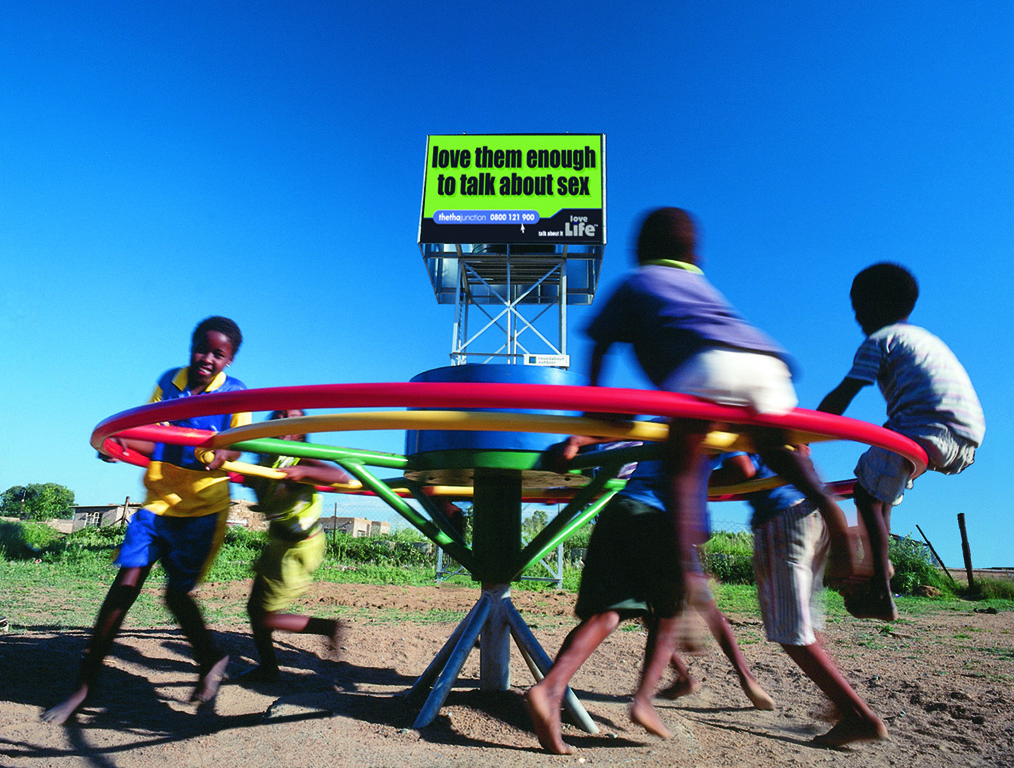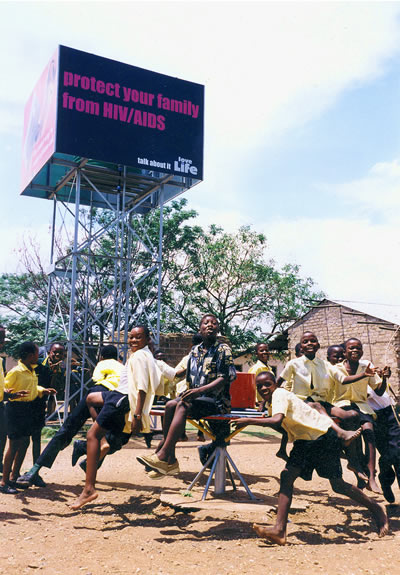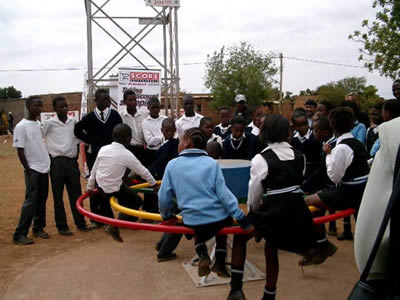


When the children ride the merry-go-round, water is pumped into the nearby water tower. Public health and HIV/AIDS awareness posters always occupy two of the water tower’s four billboards. All photographs Roundabout Outdoor
| Location | South Africa |
| Date | 1996 |
| Design Team | Trevor Field, Ronnie Stievers |
| Engineer | Paul Ristic |
| Manufacturer | Roundabout Outdoor |
| Major Funding | International Finance Corporation (World Bank), UNICEF, Kaiser Foundation, South African Department of Water Affairs and Forestry, various advertisers |
| Cost | $8,500 (including maintenance) |
Interview
Trevor Field Roundabout Outdoor
The idea behind the Play-Pump is simple: Use the energy of children at play to pump water.
When first designed by Ronnie Stievers, the pump had enormous potential to bring clean water to South Africa’s rural communities. Children, who are often responsible for water collection, spin on the roundabout, forcing 318 gallons (1,400 L) of water per hour from 130 feet (40 m) below ground into a 568-gallon (2,500-L) storage tank, tapping enough water to meet the daily household needs of a small community. There was only one problem: How to make the pump, which cost three times as much as a typical pump, economically viable in places where it was needed most. Enter advertising executive Trevor Field.
How did the idea for the Play-Pump come about?
The equipment that goes underground is windmill equipment—it’s not rocket science. We’ve not reinvented the wheel; we’ve just taken the best parts of the design and modified it so that we have a consistent energy source, which is the children.
I found the pump in 1992 [and] bought the patent from Ronnie Stievers, who invented the system in South Africa. He got a [standard playground] roundabout pumping water, and I saw it and said, “Sell it to me.” He was going to sell it because it was five times the cost of a hand pump, and he couldn’t make it profitable on its own.
What changes did you make to sell it as a community water pump?
We had to make it affordable. So I came up with the advertising idea to subsidize the cost of the pump.
We also designed a force head, a one-way valve that holds the water at the surface and allows it to be pumped to an overhead storage tank. [Roundabout Outdoor] partner Paul Ristic designed the system. When the pump is operating it holds the water at the top of the tank, so that water is available immediately.
My wife installed the first ones in 1994 while I was working in advertising and couldn’t get away from my desk. They are still operating. We’ve updated them, but they are very reliable. We try to install them near schools, so kids will go. If you want to get a girl to go to school, put water in the school. Girls miss out on 25 percent of their education because of lack of water and sanitation at schools, which leads many girls to stay home when they are menstruating.
How much does it cost and how do communities pay for it?
Users don’t pay for the pump at all, advertisers do. It’s a bit of a Robin Hood exercise. The cost for the pump is just under $9,000, but that includes the cost of full installation anywhere in rural South Africa and 15 years of maintenance. If you don’t consider maintenance, the stuff begins to fall apart instantly. Especially because ground water is free, and because people don’t pay for water, [the pump generates] no maintenance budget. So we pay for maintenance with the revenue we get from advertising. Each pump has a toll-free number on it, and anyone can call and notify us that a pump is out of order.
The advertising is critical to paying for the pump. A lot of Doubting Thomases say that you can’t get effective advertising into remote places in South Africa. We’ve proved the opposite. This is one of the only opportunities in rural areas.
Who are some of these advertisers?
All sorts of people: Coke, Unilever, Colgate Palmolive, big super-markets like Spar. The [South African government] Electricity Board.
It’s a very good platform for introducing new products like electricity, for instance, for warning people about the dangers of electricity. All manner of things are advertised because there isn’t another medium. There is no TV, rarely even any radio.
Not only have we got a water pump, we’ve got a medium for important messages. In Africa we have the equivalent of the Indian Ocean tsunami every three or four months. [For example] the Kaiser Foundation advertises HIV awareness.
[The world] loses 6,000 people every day due to inadequate water or poor sanitation. It is the equivalent of 20 747 jets crashing every day with no survivors. And this disaster is preventable.
[Africa loses another 6,000 people each day to HIV/AIDS.] Women and young girls are the most vulnerable population on the planet for HIV and AIDS, and they don’t understand this. Most of the education efforts are in cities. Eighty percent of the problem in Africa is in rural areas, and we are trying to reach them. We’ve got to try to keep them HIV negative, and if you can put a message in a place where you make somebody’s life easier, you had better believe they will remember it.















READ OR LEAVE A COMMENT